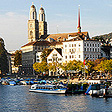GROSSMÜNSTER
CATHEDRAL – ZURICH
The Saints of Zurich and Face of Charlemagne
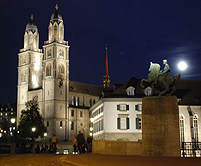 Cities
of the world have their founding symbols; curiously brothers seem to
play a
role
in many. Rome has its Romulus and Remus and Zurich
its Felix and Regula. Two brothers who survived the slaughter of their
early Christian order by the Romans in what is now the Vallais region
of Switzerland in the 3rd Century, escaped to the north along the Limmat
River. The lurid legend has it, they were captured and beheaded, but
arose to their feet, picked up their decapitated heads and walked 30
paces to the spot where they wanted to be buried. About 600 years later,
the Frankish king and later Emperor Charlemagne, an avid hunter if
ever there was one, chased a stag all the way from Aachen in Germany
to Switzerland and while hot after the elusive deer, his horse stumbled
on the tomb of the martyred brothers. It was at this spot, Zurich’s
great symbolic cathedral was built (see Charlemagne Cathedral Aachen).
Cities
of the world have their founding symbols; curiously brothers seem to
play a
role
in many. Rome has its Romulus and Remus and Zurich
its Felix and Regula. Two brothers who survived the slaughter of their
early Christian order by the Romans in what is now the Vallais region
of Switzerland in the 3rd Century, escaped to the north along the Limmat
River. The lurid legend has it, they were captured and beheaded, but
arose to their feet, picked up their decapitated heads and walked 30
paces to the spot where they wanted to be buried. About 600 years later,
the Frankish king and later Emperor Charlemagne, an avid hunter if
ever there was one, chased a stag all the way from Aachen in Germany
to Switzerland and while hot after the elusive deer, his horse stumbled
on the tomb of the martyred brothers. It was at this spot, Zurich’s
great symbolic cathedral was built (see Charlemagne Cathedral Aachen).
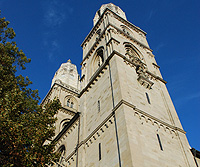 Grossmunster (meaning
large or great monastery cathedral), in its current form built around
1100, stands on a hill above the river which
divides the Swiss capital city of Zurich, with its unique helmeted
twin bell towers iconic symbols of Zurich. The Grossmunster Cathedral’s
architecture is primarily Romanesque and notably rather austere in
its interior decoration, due to the influence of its place in the reformation.
The Grossmuster Cathedral historically is most associated with Ulrich
(Hyuldrich) Zwingli, who became the pastor of the Grossmuenster in
1519. Martin Luther had nailed his 99 thesis to the doors of the Castle
Church in Wittenberg two years before in 1517 (see Luther’s
Church Doors). Zwingli brought the
Grossmunster (meaning
large or great monastery cathedral), in its current form built around
1100, stands on a hill above the river which
divides the Swiss capital city of Zurich, with its unique helmeted
twin bell towers iconic symbols of Zurich. The Grossmunster Cathedral’s
architecture is primarily Romanesque and notably rather austere in
its interior decoration, due to the influence of its place in the reformation.
The Grossmuster Cathedral historically is most associated with Ulrich
(Hyuldrich) Zwingli, who became the pastor of the Grossmuenster in
1519. Martin Luther had nailed his 99 thesis to the doors of the Castle
Church in Wittenberg two years before in 1517 (see Luther’s
Church Doors). Zwingli brought the 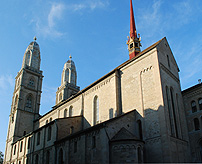 reformation to Switzerland,
advocating the marriage of priests and the end of fasting for lent.
He also objected
to the practice of Swiss soldiers hiring out as mercenaries and denounced
the artistic symbology of the Catholic Church, removing the adornment
of churches. Zwingli’s reforms were furthered by Heinrich Bullinger,
the next pastor of Grossmunster who along with Calvin solidified Switzerland’s
reformed church, which influenced the Presbyterians and Calvinists
who brought their ideas to the American colonies.
reformation to Switzerland,
advocating the marriage of priests and the end of fasting for lent.
He also objected
to the practice of Swiss soldiers hiring out as mercenaries and denounced
the artistic symbology of the Catholic Church, removing the adornment
of churches. Zwingli’s reforms were furthered by Heinrich Bullinger,
the next pastor of Grossmunster who along with Calvin solidified Switzerland’s
reformed church, which influenced the Presbyterians and Calvinists
who brought their ideas to the American colonies.
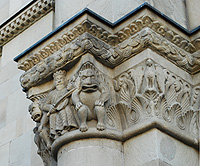 While
most of the cathedral is Romanesque, later Gothic features were added
and the
bell tower caps are actually an early neo-gothic addition
from the 18th Century, added following a fire in 1786. Many of the
early paintings inside the church are faded. The best preserved is
an image
of Christ Arisen surrounded by torture instruments, the meaning of
which is open to a couple of interpretations. A number of interesting
Romanesque period figures adorn the main portal, a capstone relief
of either King David or Orpheus (no-one is sure) with a lyre sits
surrounded by lions. The heavy bronze doors of more identifiable
sculpted bible stories
of the west portal were created in 1950.
While
most of the cathedral is Romanesque, later Gothic features were added
and the
bell tower caps are actually an early neo-gothic addition
from the 18th Century, added following a fire in 1786. Many of the
early paintings inside the church are faded. The best preserved is
an image
of Christ Arisen surrounded by torture instruments, the meaning of
which is open to a couple of interpretations. A number of interesting
Romanesque period figures adorn the main portal, a capstone relief
of either King David or Orpheus (no-one is sure) with a lyre sits
surrounded by lions. The heavy bronze doors of more identifiable
sculpted bible stories
of the west portal were created in 1950.
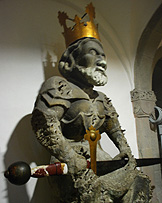 Charlemagne’s
(Charles the Great) connection to the Grossmunster legend had been
noted by a regal statuary figure of the great king, sitting on a
throne, sword in hand, gold crown on his head, high on the west wall
from the 15th Century. The king who now sits outside is
actually
a copy
replacing the original, which was suffering damage from exposure.
But if you want to stare straight into the face of Charlemagne, the
original now resides in the crypt under of the
church, where his majesty is obviously more comfortable.
Charlemagne’s
(Charles the Great) connection to the Grossmunster legend had been
noted by a regal statuary figure of the great king, sitting on a
throne, sword in hand, gold crown on his head, high on the west wall
from the 15th Century. The king who now sits outside is
actually
a copy
replacing the original, which was suffering damage from exposure.
But if you want to stare straight into the face of Charlemagne, the
original now resides in the crypt under of the
church, where his majesty is obviously more comfortable.
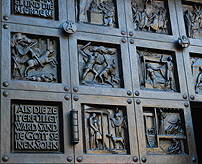 And
the curious story of Felix and Regula is not complete. For a few
hundred years
in medieval times, the relics of the saints were carried
in an annual procession across the Limmat River between the competing
monasteries of Grossmunster and Fraumunster (now most noted for its
Marc Chagall stained glass windows), until Zwingli and his reformation.
One story has it that in 1524, Zwingli, not so revered of the relics
of Catholic Saints, dug up their tomb and buried a few small bone fragments
he found in a common grave. The Catholic version of the story has it
that he only found a few fragments because the bones were stolen by
a fellow from Uri near Lake Lucerne, who took them to safety. The two
skulls of the martyrs can still be seen in a church in Andermatt, though
like the mystery of Shroud of Turin their authenticity has been open
to question. The remaining
bone relics were returned to Zurich in 1950 where they reside in
the St Felix and Regula Catholic Church.
And
the curious story of Felix and Regula is not complete. For a few
hundred years
in medieval times, the relics of the saints were carried
in an annual procession across the Limmat River between the competing
monasteries of Grossmunster and Fraumunster (now most noted for its
Marc Chagall stained glass windows), until Zwingli and his reformation.
One story has it that in 1524, Zwingli, not so revered of the relics
of Catholic Saints, dug up their tomb and buried a few small bone fragments
he found in a common grave. The Catholic version of the story has it
that he only found a few fragments because the bones were stolen by
a fellow from Uri near Lake Lucerne, who took them to safety. The two
skulls of the martyrs can still be seen in a church in Andermatt, though
like the mystery of Shroud of Turin their authenticity has been open
to question. The remaining
bone relics were returned to Zurich in 1950 where they reside in
the St Felix and Regula Catholic Church.
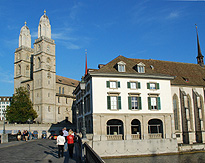 Below
the Grossmünster, on the main street along the Limmat
River where the bridge crosses between the former rival monasteries,
the
Wasserkirche stands on the spot where Felix and Regula were beheaded,
with the “Martyr Stone” in the crypt where their execution
took place. The figures of Felix and Regula, along with their servant
Exuperantius, executed with them, still adorn the coat of arms and
seal of the city of Zurich. © Bargain
Travel Europe
Below
the Grossmünster, on the main street along the Limmat
River where the bridge crosses between the former rival monasteries,
the
Wasserkirche stands on the spot where Felix and Regula were beheaded,
with the “Martyr Stone” in the crypt where their execution
took place. The figures of Felix and Regula, along with their servant
Exuperantius, executed with them, still adorn the coat of arms and
seal of the city of Zurich. © Bargain
Travel Europe
Compare best hotel and travel deals in Zurich on TripAdvisor
Web Info
Grossmuenster
These articles are copyrighted
and the sole property of Bargain Travel Europe and WLPV, LLC. and
may not be copied or reprinted without permission.
SEE
ALSO:
BEYER
CLOCK & WATCH MUSEUM ZURICH
ZURICH
FOR THE HOLIDAYS
ST
GALLEN ABBEY BAROQUE LIBRARY & CATHEDRAL
RAPPERSWIL
WOONEN BRIDGE ON LAKE ZURICH
ABBEY
OF ST MAURICE MARTYRS & TREASURES

